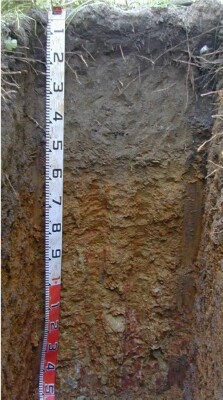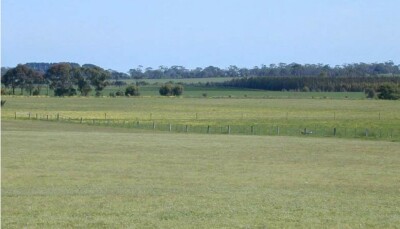| A11 | 0-15 cm | Very dark brown (10YR2/2) loamy sand, weak polyhedral structure (10-20 mm), very weak consistence when moist, many medium roots. Clear and smooth transition to: |  |
| A12 | 15-35 cm | Very dark brown (10YR2/2) with many coarse dark faint yellowish brown (10YR4/4) mottles, sandy loam, weak polyhedral structure (10-20 mm), very weak consistence when wet, many very fine macropores, areal porosity 1.0 %, common fine roots. Clear and smooth transition to: |
| A2 | 35-45 cm | Very dark brown (10YR2/2) with many coarse dark faint yellowish brown (10YR4/4) mottles, sandy clay loam, weak polyhedral structure (10-20 mm), very weak consistence when wet, many very fine macropores, areal porosity 1.0%, common very fine roots. Clear and smooth transition to: |
 | Subsoil |  |
| B1 | 45-55 cm | Dark brown (10YR4/3) with many coarse faint dark yellowish brown (10YR4/8) mottles sandy clay, unable to assess structure, consistence or macroporosity due to very many segregations present, very many coarse ferruginous nodules, few very fine roots. Abrupt and smooth transition to: |
| B21 | 55-80 cm | Yellowish brown (10YR5/6) with many coarse distinct yellowish red (5YR4/6) mottles, light medium clay, moderate polyhedral structure (20-50 mm) parting to moderate polyhedral structure (10-20 mm), weak consistence when moist, few medium ferruginous nodules, common very fine macropores, areal porosity 0.1%, few very fine roots. Gradual and smooth transition to: |
| B22 | 80-110 cm | Brownish yellow (10YR6/6) with many coarse distinct yellowish red (5YR4/6) mottles light medium clay, strong subangular blocky structure (10-20 mm) parting to moderate polyhedral structure (5-10 mm), weak consistence when moist, very few medium ferruginous nodules, few very fine macropores, areal porosity 0.01%, few very fine roots. Gradual and smooth transition to: |
| B23 | 110-150 cm | Very pale brown (10YR7/3) with many coarse prominent yellowish red (5YR4/8) mottles, medium clay, strong lenticular structure (20-50 mm) parting to strong polyhedral structure (10-20 mm), weak consistence when moist, very few medium ferruginous nodules, few very fine macropores, areal porosity 0.02%, few very fine roots. |
 | 150-260 cm | Similar to above. |
 | 260-420 cm | Grey heavy clay with red mottles, weaker structure, ironstone present, weathering rock, live roots observed to 300 cm, remnant roots observed to 400 cm, no impeding layer to root growth. |




